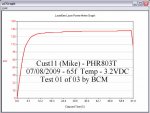- Joined
- Nov 7, 2008
- Messages
- 5,725
- Points
- 0
Here's a link to the heatsink. It's fourth on the list, HS-1b. It will not fit in a pointer, as it is for making lab-style units. A pocket mini heatsink should be sufficient for extended burns, perhaps even 100% duty at these current levels. The diode doesn't get overly warm as long as there is some form of heatsinking over and above an aixiz module.






